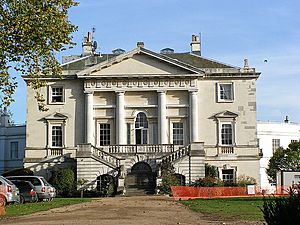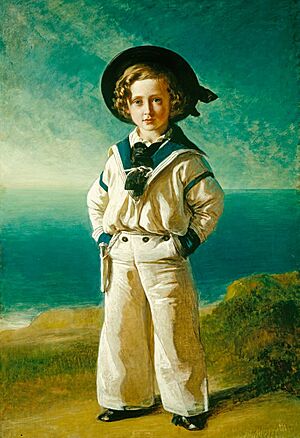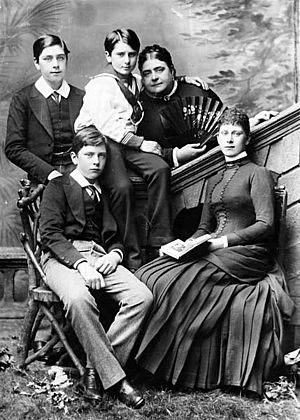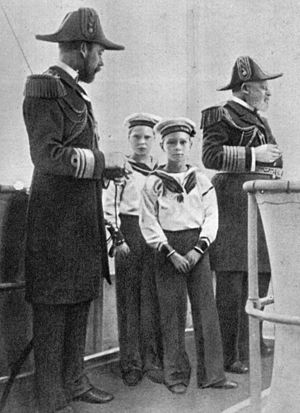White Lodge, Richmond Park facts for kids
Quick facts for kids White Lodge |
|
|---|---|

White Lodge, Richmond Park
|
|
| Location | Richmond Park, London Borough of Richmond upon Thames |
| Built | 1727–30 |
| Architect | Roger Morris |
| Architectural style(s) | English Palladian |
|
Listed Building – Grade I
|
|
| Official name: White Lodge | |
| Designated | 10 March 1981 |
| Reference no. | 1250045 |
| Lua error in Module:Location_map at line 420: attempt to index field 'wikibase' (a nil value). | |
White Lodge is a beautiful old house in Richmond Park, London. It's a Grade I listed building, which means it's very important historically. This grand house was once a home for kings and queens. Today, it's where the Royal Ballet Lower School teaches young dancers aged 11 to 16.
Contents
A Royal Hunting Lodge
White Lodge was built as a special hunting lodge for King George II. Construction started in 1727, soon after he became king. The architect who designed it was Roger Morris.
The house was finished in 1730. It was first called Stone Lodge, but then its name changed to New Lodge. This was to tell it apart from another old lodge nearby, which was later taken down in 1841. King George II had built that older lodge for Sir Robert Walpole, who was Britain's first prime minister. Walpole loved to hunt there and said he could get more work done at the lodge than in the city!
Princess Amelia's Time
Caroline of Ansbach, who was King George II's wife, often stayed at the new lodge. After she passed away in 1737, White Lodge went to her friend, Sir Robert Walpole. After Walpole's death, the house was given to King George II's daughter, Princess Amelia, in 1751.
Princess Amelia also became the "ranger" of Richmond Park. This meant she was in charge of the park. She decided to close the whole park to the public, letting only her important friends and people with special passes enter. This made the public very angry! In 1758, a local brewer took a park gatekeeper to court. The court decided that Princess Amelia had to open the park to everyone again. Princess Amelia is also remembered for adding two white sections to the main house, which you can still see today.
The Name "White Lodge" Appears
After Princess Amelia left her role in 1760, the prime minister, John Stuart, 3rd Earl of Bute, became the new ranger of Richmond Park. White Lodge was his official home.
It was during this time that the name "White Lodge" was first written down. In 1768, a lady named Lady Mary Coke wrote in her diary that she hoped to see King George III and Queen Charlotte, "tho' they are always at the White Lodge on a Sunday".
Later, after some repairs, King George III gave the house to another prime minister, Henry Addington, 1st Viscount Sidmouth. In 1805, Lord Sidmouth created the first private gardens around the lodge. King George III, who loved farming, made himself the park ranger, and Lord Sidmouth was his deputy. A famous visitor to White Lodge was Horatio Nelson, 1st Viscount Nelson, in 1805. He is said to have explained his battle plans there, just before the famous Battle of Trafalgar.
Royal Life in the 19th Century

After Lord Sidmouth died in 1844, Queen Victoria gave White Lodge to her aunt, Princess Mary, Duchess of Gloucester and Edinburgh. When her aunt passed away in 1857, Prince Albert, Queen Victoria's husband, thought White Lodge would be a good, quiet place for their son, the Prince of Wales. This son would later become King Edward VII.
Prince Albert wanted his son to focus on his studies. So, he kept him at White Lodge with only a few companions and tutors. The Prince of Wales found these years at White Lodge quite boring because he preferred more exciting company!
In 1861, after her mother passed away, Queen Victoria and Prince Albert also stayed at White Lodge for a few months.
The Teck Family and a Future King

The next royal family to live at White Lodge was Prince Francis, Duke of Teck and his wife, Princess Mary Adelaide of Cambridge. Queen Victoria let them use the house in 1869. Princess Mary Adelaide was known for spending a lot of money. Her family ended up with many debts and even had to leave the country in the 1880s to avoid the people they owed money to.

In 1891, Queen Victoria wanted to find a wife for her grandson, Prince Albert Victor, Duke of Clarence. She chose Victoria Mary, who was Princess Mary Adelaide's daughter. Sadly, Prince Albert Victor died just before their wedding in 1892. So, Victoria Mary married his brother, Prince George, Duke of York, instead. He later became King George V.
In 1894, the Duchess of York gave birth to her first child, who would become King Edward VIII, right here at White Lodge! Queen Victoria visited soon after to see her new great-grandson. He was given many names: Edward Albert Christian George Andrew Patrick David. He was baptized in the Green Drawing Room of White Lodge.
Three years later, the Duchess of Teck passed away at White Lodge. Her husband, the Duke of Teck, died there in 1900.
White Lodge in the 20th Century
After Queen Victoria died in 1901, a wealthy widow named Eliza Emma Hartmann lived at White Lodge.
The house returned to royal use in 1923 for the honeymoon of Prince Albert, Duke of York, and the Duchess of York. Prince Albert later became King George VI. Queen Mary, who had lived at White Lodge as a child, really wanted them to make the Lodge their home. In 1924, Prince Alexander of Yugoslavia was born at the house while his mother was staying there. The Duke and Duchess of York lived in the house until late 1925. After that, the building was rented out to other people.
The last private resident was Colonel James Veitch, who lived at White Lodge until 1954.
The Royal Ballet School
In 1955, White Lodge found a new purpose. The Sadler's Wells Ballet School was given permission to use the house permanently. The school later received a special Royal Charter and became the Royal Ballet School in 1956. Today, it is known as one of the best ballet schools in the world!
The Royal Ballet School also had a museum at White Lodge. It was made bigger in 2009 to include more about the history of White Lodge itself. The museum was open to the public for a few years but closed in 2015.
See also
 In Spanish: White Lodge para niños
In Spanish: White Lodge para niños
- Former royal residences
- Richmond Park
- Royal Ballet School


